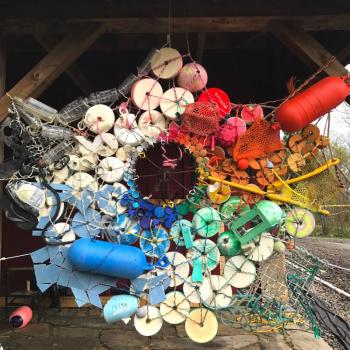Watershed senior makes swirling gyres from plastic ocean debris
Ella Simon, a senior at the independent Watershed School in Camden, loves to make art, and she plans to study the fine arts at Colorado State College next fall. She also likes to be outdoors, and for her senior project, she poured her heart and creative spirit into making art that reflects her home, the coast of Maine. She collected trash from the area, and made art from it. Below, in her own words, is a little bit about her project.
I decided to comb the coast of Camden, collect trash. Surprisingly, I found a great deal of debris, and with these materials I created a large scale sculpture, approximately 6 feet by 7 feet. Throughout the project, I did research about ocean plastic and the size of this worldwide problem, and learned some horrifying things.
Most of the plastic in the ocean is not large pieces like I found on the coast. Instead it these things called microplastics or nurdles, which are small bits of plastic, anywhere from a few millimeters in size to microscopic specks which are slowly but surely contaminating our oceans. However, it is important to collect trash from beaches like I did, because these larger pieces of plastic will eventually become microplastics, because plastic has no expiration date.
It is basically immortal.
And these microplastics collect high concentrations of toxins. Because of their range in color, marine animals at all stages of the food chain mistake microplastics for food. When they ingest these plastics, they do not digest them; rather, it tricks their bellies into thinking they are full, and the animals eventually starve.
But back to the sculpture. The whole process of creating it was very organic. I let the materials inspire the product. I began to realize how many things I collected that happened to be round in shape, like bottles, bottle caps, buoys, a metal wagon wheel head, etc, etc.
As I the sculpture came together I realized something I hadn't noticed about the piece: I was a gyre. What’s a gyre? In my research about ocean plastic I learned there are five known gyres in the world swirling areas of water, and because they move in a specific way they become the main collectors of ocean garbage.
So I began to realize that my sculpture is a gyre in itself. A swirling mass of debris. Furthermore it also reminds me of the lifecycle of microplastics. Starting from the outside of the sculpture, it is larger pieces of debris and whole objects, but as you move closer to the center it becomes smaller and smaller bits of pieces.
This project period was a very eye opening experience for me. Even in beautiful Midcoast Maine, we can see the effects of human carelessness.

























